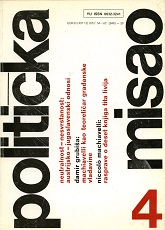Neutralnost i nesvrstanost u Evropi
Neutrality and Non-Alignment in Europe
Author(s): Radovan VukadinovićSubject(s): International relations/trade, Security and defense, Military policy
Published by: Fakultet političkih znanosti u Zagrebu
Keywords: Neutrality; Non-Alignment; Europe;
Summary/Abstract: In the present state of economic crisis, disrupted detente and contest in military technology, European communication channels have been narrowed in virtually all areas of East-West relations, thus basically restricting also European co-operation. This confirms once again that security and co-operation comprise two sides of a single process, i.e. that without security there can be no co-operation, in the same way as there can be no security without co-operation. The deterioration of international relations is attended by endeavours to impose discipline on the members of military-political alliances and by the attempts of their leaders to present them as factors of partial security. This state of affairs lends special significance to countries seeking scope for activities free of bloc considerations and approaches, such as are the non-aligned and neutral countries. The ideas of non-alignment are considerably m ore present and influential in Europe than would appear from the number of European non-aligned countries. Thus, for example, all initiatives and efforts of bloc countries to develop a m ore independent approach to international relations look for support also in the objectives and principles of non-alignment. The policy of non-alignment is upheld, or considered an important political ally against bloc divisions, by a number of West European left-wing parties. The various form s of co-operation between 'active’ neutral and non-aligned countries of Europe are becoming increasingly important models of functional linkage among various European states.
Journal: Politička Misao
- Issue Year: XX/1983
- Issue No: 04
- Page Range: 3-12
- Page Count: 10
- Language: Croatian

